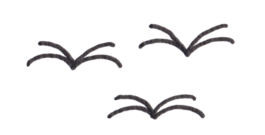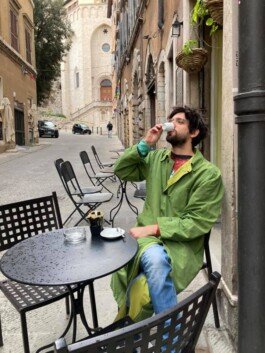
A conversation with Antonio Brizioli
by Sara Azzarelli, April 2021

Edicola 518 is a landmark newsstand at the heart of Perugia city in Italy. It has been a home for a Dance Mag since 2018. The Emergenze group, which founded the famous kiosk, has also recently opened another fascinating space called Paradise 518, just a mere 30 m away from the Kiosk.
Sara Azzarelli from our ‘a Dance Mag’ team got together with Antonio Brizioli, one of the founders of these two lovely spaces, for a little conversation. It was a Thursday evening, and. since Italy is in semi-lockdown, the conversation took place on Zoom – like most of our social life these days. After the usual ‘Can you hear me? I cannot see you! Is the connection ok?’ the conversation finally started.
Hi Antonio, my first question is an alternative way of asking how is your life going. Tell me up to three things that have brought you joy over the last months.
(Laugh) Well, first of all, I am grateful for the fact that I have an actual workplace and I am not sitting in front of a laptop at home all day the way most people are forced to endure these days. Every morning I wake up and go to my Paradise 518. It feels good to have to go somewhere, to have something to take care of. Second, we are working on several projects while waiting for the situation to unblock. So that is exciting too! And books, of course! Books always bring me joy. Luckily, I am surrounded by lots and lots of them.
Projects … I have seen wonderful posts on your Facebook and Instagram pages and I want a spoiler!
Sure! We are working on two main projects. We released the second volume of ‘Lezioni di Anarchia’ (Anarchy Lessons) in January. We took advantage of this static period to focus our energy and concentration on it, so it is a great joy to have it released. The book stands in many libraries and we have already distributed more than 500 copies. But we won't feel satisfied until we get to present it in live events. Hopefully, we’ll be able to do that this year.
The other project is called “Sant’Ercolano Theatre.” It is a program we are putting together to animate St. Ercolano Square, the beautiful square in front of our Edicola that has hosted our events over the past five years. You know it well because you have presented a Dance Mag and performed there in 2019! Thanks to the funding of the Umbria region and several partnerships, this year St. Ercolano Square will host a richer and more diverse season of performances, readings, and more events. This project is particularly meaningful to us because it allows us to re-appropriate the urban space – an aim that has characterized our work from the very beginning. We feel more intensely about re-appropriating urban spaces in these days of everyone being locked in and isolated.
That sounds so exciting! I hope we will be allowed to move between regions by the time the events start! Speaking of live events and being interactive, our magazine aims to do something similar. It attempts to give readers an immersive experience, waking up their senses. How you approach a magazine or a book? What attracts your attention?
My approach is extremely tactile; I’m on your side. I’m aware that magazines and books which have peculiar and distinctively beautiful designs may sometimes be experienced simply through the sense of sight, as flat 2-dimensional objects. But what I love about paper is rather 'volume.' I love to feel the weight of books, I love to drop them and hear the sound they make, thudding onto a table or on the floor. Also, I like the smell of paper too. I wouldn’t go as far to say that the visual aspect is not important but, for me, it is not the most important aspect. I appreciate print publications because they have a weight and density and texture.
I’m really curious about your opinion then. How did you react when you received our most recent issue of the magazine? We go way back, so feel free to be totally frank.
I really like it! The cover page is somehow gritty stimulating an urgent need for tactile interaction in a moment where being able to touch is particularly important and particularly missing. This struck me in a positive way because I can see how your magazine is evolving. With time and experience, you start to notice the subtle differences in these matters and to realise, for example, how a specific type of paper may or may not mirror what you want to express. For your first issue, you started with a totally smooth cover and slightly flimsy paper, but you were going for an eye-catching bright color. Now, the cover is textured and the paper is rough, more alive in a different way.
Ah, good to hear! Yes, the theme of the issue was Touch after all. So, tell me, what is the first image that comes to your mind when you hear this word, ‘Touch’?
A hug. I really miss hugging! I don’t feel comfortable living in a time where we cannot hug our friends and there is always this awkwardness about not greeting people with a hug, the way we normally do in our culture.
Do you think that in non-pandemic times this word would have evoked the same image to you?
That’s hard to say, but in my mind, hugs mark important moments. I associate this image with specific memories – both positive and negative. So yes, it would have probably come to my mind even before the pandemic.
One last question: I was wondering whether you have a favorite time & space to read.
During this last year, reading has become my first daily activity. When I wake up, I enjoy staying in bed for an hour or so just to read. I think that reading in the morning makes so much sense, especially for readings that require concentration. Also, this practice postpones the daily phone addiction, which is unavoidable because work and the pandemic. So now, the first thing I turn to once the day starts is not my phone, but a book or a magazine. It gives me a little hour of introspection.
Our pleasant little Zoom call ended by talking about phone addiction, how much we miss touching people, and wondering about how future practices of being together will be. Looking forward to events that would recreate a tangible human network in the urban space. Lastly, of course, a virtual hug before the screen goes black.